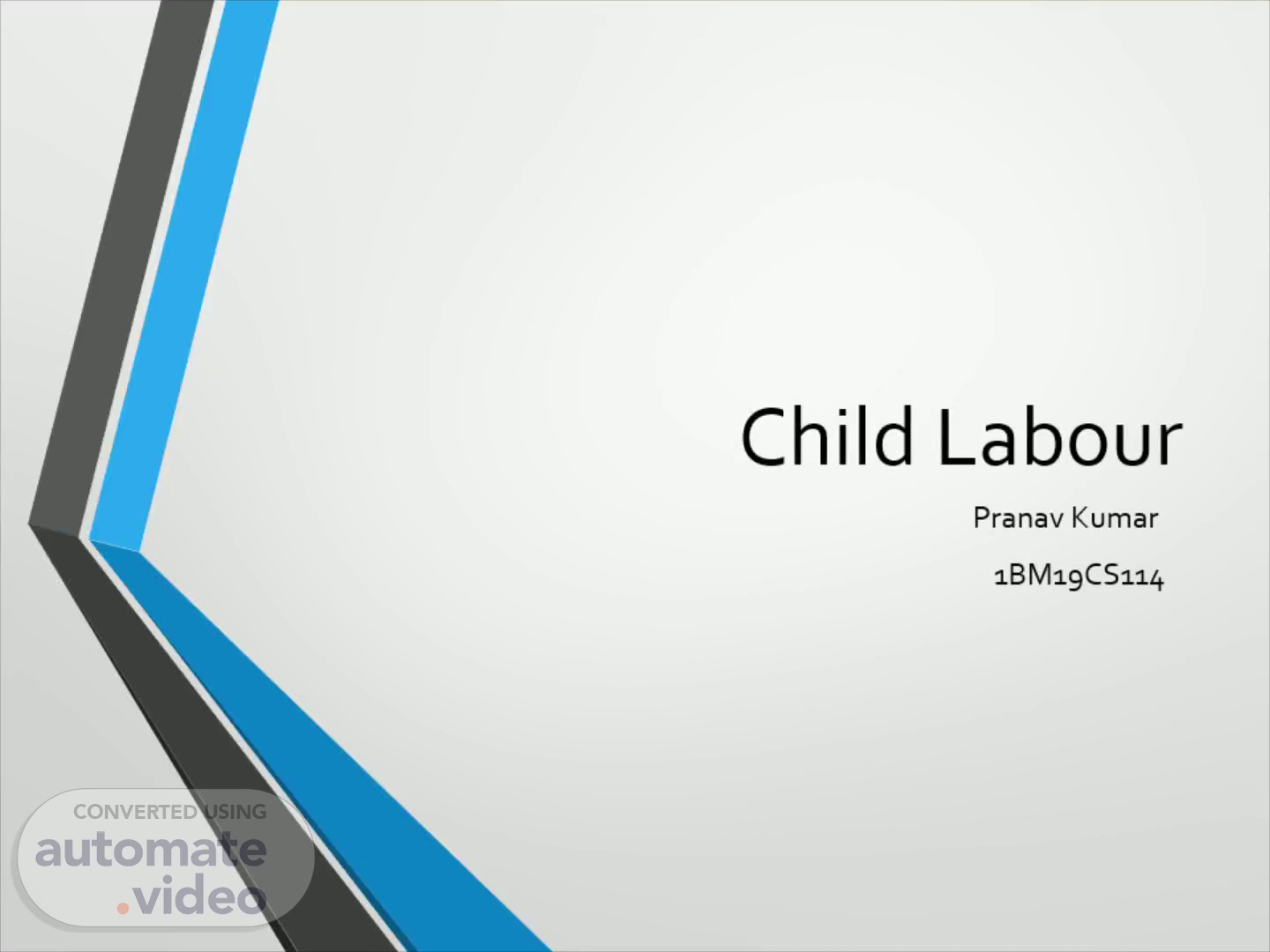Scene 1 (0s)
Child Labour. Pranav Kumar 1BM19CS114.
Scene 2 (6s)
Objectives. Define child labour and how it has evolved over the years. Analyze the supportive and opposing arguments to develop your own opinion on child labour. Explain the health care provider’s role in terms of caring for children omitted to child labour..
Scene 3 (21s)
Only estimates exist, but at least 250 million children between the ages of 5 and 14 work for a living in developing countries, nearly half of them full time . (WHO 2010).
Scene 4 (33s)
Relevant Terms. Child labour - refers to children performing work that is exploitative or detrimental to their development (Conley 2000) Child labourer - a child denied the liberating benefit of education, one whose health, growth and development are threatened, who risks losing the love, care and protection of family and who cannot enjoy the rest and play that are every child’s right. (WHO 2010).
Scene 5 (52s)
Terms cont’d. Child Protection Violation (UNICEF 2009) International Labor Organization (ILO) The ILO is the UN-specialized agency seeking the promotion of social justice and internationally recognized human and labour rights. Distinguishes between harmful and non-harmful work Harmful work : work in the industrial sectors ; considered stressful and presenting high risks of exposure to radiation and hazardous chemical substances Non- harmful work: work in the family unit.
Scene 6 (1m 12s)
History of Child Labour. In 18th century, child labor was accepted by many. Throughout the 18th century misconceptions about children increased child labour During the Victorian Era, increased in population in Great Britain worsen child labour. The Industrial revolution in Canada also increased child labor practices. In 1920, legislations were constructed to secure children rights and their education..
Scene 7 (1m 35s)
The Evolution of international standards on child rights.
Scene 8 (1m 52s)
1973 - The International Labour Organizations adopts Convention No. 138 on the Minimum Age for Admission to Employment 1989 - The UN General Assembly unanimously approves the Convention on the Rights of the Child 1999 - The International Labour Organization adopts Convention No. 182 concerning the Prohibition and Immediate Action for the Elimination of the Worst Forms of Child Labour . 2002 - The UN General Assembly holds a Special Session on Children, meeting for the first time to specifically discuss children’s issues..
Scene 9 (2m 16s)
Current Influences. sran156l.
Scene 10 (2m 22s)
Understanding why a family sends a child into child labour.
Scene 11 (2m 38s)
Understanding cont’d. Assumed that families are not in the business of exploiting children; and that the work is judged not be hazardous to their physical, mental, or moral health Important to note that exploitation cannot be ruled out.
Scene 12 (2m 52s)
Socio-economic reality. Different in developed and under-developed countries Child labour : 1. Sustains standards of living in some households 2. Children are generally from most marginalized backgrounds; living in extreme poverty e.g. in the case of debt bondage.
Scene 13 (3m 8s)
Formal economy. Mainly private companies e.g. factory work, mining. These employment markets exploit children in the form of wages Children just seen as minors rather than workers whose rights have to be respected..
Scene 14 (3m 23s)
Formal economy cont’d. Status as a minor: 1. leaves child worker open to any form of abuse 2. cannot claim own rights or better working conditions 3. not entitled to join any union where their voices will be heard Result: many resolve to work in the informal economy.
Scene 15 (3m 39s)
Informal economy. Children work as helpers, apprentices or do casual labour in family businesses, artisan work or domestic chores. Sector has own set of operating rules making it difficult to ensure application of labour legislations.
Scene 16 (3m 54s)
Childhood & work. Every society perceives children and work differently This makes it difficult to harmonize and apply international laws in relation to child labour Conventions on child labour leave a lot of room for maneuver; currently, there are attempts to establish universal standards..
Scene 17 (4m 10s)
International conventions. Find it difficult to ban child labour because: 1. Are not in a position to support households involved in it 2. Banning children from working would mean taking responsibility for poor families who at present manage to survive without help.
